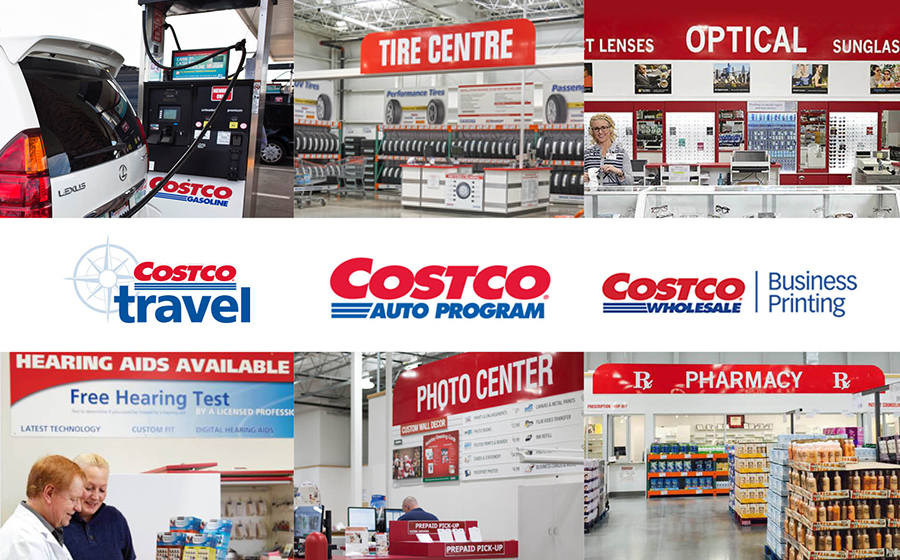Costco\’s ancillary services strategy is a major traffic and membership builder, which they continue to expand on, particularly gas stations. It\’s also a big business, (about $30 billion). The services strategy model is also coming out from under the radar for many other legacy retailers. It\’s a big deal. But I\’m not sure how much of a big deal retailers, including Costco, realize it is. For Costco, it\’s business as usual. My position is that it\’s one of the key pillars on which old world brick-and-mortar retailers can transform their models to gain new customers and increase the visitation rates of existing customers. It\’s also a strategy that cannot be easily implemented by e-commerce: think the apocalypse messenger, Amazon.
The strategy is simply to provide ancillary services. What? How passive and non-energetic is that description? It\’s like, \”Oh, by the way, we also have ancillary services,\” blah, blah, blah. In reality it\’s way bigger than an \”Oh, by the way.\” So, I want to dig deeper into the logic of the strategy and how it can be a hugely powerful growth engine. In fact, I believe it may become a more powerful brand and revenue builder than the stuff sold within the brands\’ stores.
But first, a quick review of Costco and why it\’s the poster child for an ancillary services strategy.
Costco in Context
Costco has what some call a cult following. At the very least it\’s an addictive treasure hunt destination that can\’t be replicated by others online or offline. I coined the description of their loyal customers as \”Costcoholics.\” Costco carries narrow, highly curated assortments (based on local preferences) of food and beverages, encompassing dry and packaged foods, alcoholic (largest wine purveyor in the U.S.) and nonalcoholic beverages, snack foods, candy, fresh produce, meat, deli and bakery. They carry apparel and small appliances; hardlines include larger appliances, electronics, home improvement merchandise, health and beauty products. And all of these categories are priced lower than Amazon can even match. Costco is able to maintain their pricing strategy because their members (around 94 million in 2018) pay an annual fee of $60 ($120 for a premium membership) and 90 percent rejoin every year. The membership fees account for about 75 percent of Costco\’s earnings. That\’s why Costco\’s competitive pricing trumps everybody else, Amazon included. Annual revenues are pushing towards $150 billion, growing 8 to 9 percent annually.
Costco turns over its entire inventory 12 times per year, which makes the Costcoholics return faster and more often to get their fix (an average of three times a week). And then there\’s the luxury \”surprise\” of the week, the totally unexpected treasure that one might find in upscale department stores, certainly not in Costco. Surprises like Waterford Crystal, Coach handbags, Omega watches, Andrew Marc, Calvin Klein, Adidas, Chanel, Breitling and many more are offered at incredibly low prices. Consumers hunt for these surprises weekly. Other treasures include electronics, appliances and other less frequently purchased finds at extremely good prices.
Services Could Replace Stuff as the Primary Destination Driver
So enough on context. Now onto why services could become more of a destination driver for consumers than the stuff legacy retailers are currently selling in their stores. Using Costco as an example, the big strategic aha is how their addicted cult has supported everything the brand does. Because Costco constantly delivers beyond expectations, over time they have won their customers\’ unquestioned loyalty and trust. This allows the brand to expand its DNA to include almost anything their consumers need and want — or more interestingly what they didn\’t know they wanted until Costco presents it to them.
The Costco services role call: gas stations, pharmacies, food courts, hearing aid centers, photo processing centers, travel centers, optical dispensing centers (at a majority of its warehouses), Budget truck rental, business printing, prescription programs, RV rentals, mortgage purchase and refinancing, life insurance, dental plans, identification protection, Costco auto program, auto and home insurance, business and personal checks, bottled water delivery, business health insurance and Costco auto leasing.
Many of these are collaborative third-party services that consumers are inclined to use because they have been curated and have Costco\’s stamp of approval. And most importantly, these services are offered by Costco engendering members\’ trust in the brands along with the convenience and ease of accessing these services — cruising the food aisle and going online to rent an RV, checking out life insurance rates or planning a vacation all add up to big business. These services account for about 20 percent of Costco\’s annual revenues, or about $30 billion.
Perhaps the most powerful driver for visitation and new membership are Costco\’s gas stations. Costco not only has cheaper gas than stations it directly competes with, but it\’s also less expensive than other warehouse club chains. This alone compels consumers to become members. There are about 567 Costco gas stations connected to their roughly 768 warehouses across the globe, accounting for roughly $9 billion in sales or about a third of the total revenues of ancillary services.
While Costco is likely not the first retailer to adopt and build a major services business, it may be the largest in terms of revenues. Therefore, I use it as a poster child example for what I believe all retailers and brands should make a strategic priority for synergistic growth, While most of the major retailers provide services, they are in the \”oh by the way\” bucket, kind of dormant and under the radar. It\’s time to shine the light on them (marketing) as well as identifying new services that compliment and create a synergy with the DNA of their brands.
Kohl\’s and Nordstrom Services
Two of the more imaginative examples of services in legacy retail are Nordstrom Local and Kohl\’s collaboration with Amazon. Nordstrom\’s local strategy of building out small neighborhood locations (roughly 3000 square-feet) for services only (no merchandise), which I describe as a \”triple-header,\” personalization, experience and BOPUS is being tested in major urban areas. Nordstrom Local is a desirable go-to destination for convenient online order pickups or returns, free tailoring, shoe and handbag repairs, gift wrapping and personal stylist assistance to place online orders while enjoying a manicure and beverage of your choice.
And then there\’s Kohl\’s, who some say is dancing with the devil in its collaboration with Amazon. Kohl\’s is rolling out the Amazon \”shop-in-shop\” model to all of its roughly 1155 stores to accept Amazon returns. The traffic building synergy is awesome. According to some analysts, Kohl\’s Chicago test of the model spiked comp store sales about 9 percent vs. 1 percent elsewhere. Out of all shoppers who returned Amazon products, 56 percent were new to Kohl\’s or customers who hadn\’t been to the stores for nearly a year. Furthermore, Kohl\’s sells Amazon-branded products in its stores transitioning from the store-within-a-store concept to a wholesale relationship with Amazon.
These are just two examples of legacy retailers who are thinking out of the box and creating service synergies that are compelling enough to get the digital-addicted young consumer culture to pocket their smartphones and go for a physical, convenient and pleasant experience. And by the way, they will come to you more often, they will stay longer and will buy more. Get it? Services become the main event. Stuff becomes \”oh, by the way.\”




